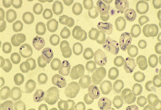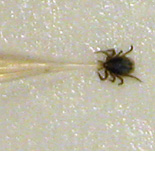 |
||||
The Division of Bacteriology & Parasitology encompasses research, training and service on features of the pathogenesis, diagnosis, treatment, transmission, and prevention of bacterial and parasitic diseases. Personnel devoted to research and its ancillary functions include five faculty, four postdoctoral fellows, one research scientist, two graduate students, six research technicians, and one administrative staff. Dr. Mario T. Philipp, Professor of Microbiology and Immunology at Tulane Medical School, is Chairman of the Division. The functions of the Division can be divided into three main areas: 1) Research, 2) Research Resources and 3) Education and Training Opportunities. RESEARCH PROGRAMSResearch in the Division currently centers on five diseases: Lyme disease, malaria, pneumonia caused by Streptococcus pneumoniae, tuberculosis, and brucellosis. Lyme diseaseThe most extensive divisional program is on Lyme disease, or Lyme borreliosis. An emerging infectious disease that affects people in North America, Europe, and Asia, Lyme borreliosis is caused by the spirochete Borrelia burgdorferi and is transmitted by ticks. The disease may manifest in numerous ways, e.g. as an inflammation of the skin (erythema migrans), as arthritis, and in the peripheral and central nervous systems as, for example, facial paralysis and through neurocognitive symptoms. Lyme disease that affects the nervous system is also called Lyme neuroborreliosis. After developing a nonhuman primate model of Lyme disease, divisional faculty are currently using this model to try to understand the pathogenesis of neuroborreliosis of the central nervous system. Improvement of methods for the serological diagnosis of Lyme disease is also of major interest to divisional faculty. The significance of this line of research stems from the fact that Lyme disease that is accurately diagnosed early in the course of infection is more efficaciously treated with antibiotics than when the disease remains undiagnosed for extended periods. The C6 test, an antibody detection assay that is more sensitive and specific than the tests available heretofore, was developed by investigators in the Division. An additional advantage is that the test does not yield false-positive results with serum specimens from humans or dogs that have received Lyme disease vaccination. The test was approved by the FDA and the USDA for human and animal use, respectively, and licensed by Tulane University to Immunetics, Inc., of Cambridge, MA, for human use, and to IDEXX Laboratories, Inc. of Westbrook, ME, for veterinary purposes. Currently research on diagnosis is focused on the C6 test as a predictor of Lyme disease therapy outcome, a possible new application of the test. The spirochete B. burgdorferi has evolved numerous mechanisms of adaptation to which it must resort in order to survive in different host organs, in environments as dissimilar as ticks and mice, and in the face of a swift and intense immune response. Divisional scientists are researching the mechanisms of gene regulation that underpin these survival stratagems. Important findings have been made in relation to spirochetal adaptation to different cell densities and to changes in environmental pH and temperature, as well as relating to the ability of this organism to circumvent the antibody response of the host. MalariaMalaria, a mosquito-borne disease, is a major global health concern. The development of safe and effective anti-malarials is a worldwide priority, especially as treatment with chloroquine, the drug of choice for malaria for over 50 years, has been compromised by the increasing prevalence of chloroquine-resistant malaria parasites worldwide. A long-standing collaboration between investigators of the Division and the Department of Tropical Medicine and Parasitology of the Tulane School of Public Health and Tropical Medicine is devoted to developing new drugs that may be active against Plasmodium falciparum malaria strains that are resistant to chloroquine. A basic study of key features of the host response to infection with another species that causes malaria, namely, Plasmodium vivax, also is being investigated through this same collaboration. Using human DNA microarrays and peripheral-blood mononuclear cells obtained from rhesus macaques that were infected with a simile of P. vivax, the monkey parasite P. cynomolgi, divisional investigators are studying transcriptome profiles of host gene expression during infection. Pulmonary diseases: tuberculosis and pneumoniaThe Division is in the process of expanding its research areas by attracting new faculty to work on the pathogenesis and immunoprophylaxis of tuberculosis and with new research initiatives in the area of pathogenesis of pneumonia due to Streptococcus pneumoniae. TuberculosisTuberculosis (TB), along with AIDS and malaria, is one of the three major infectious disease killers. One third of the world’s population is infected with Mycobacterium tuberculosis. Each year an estimated eight million people develop, and about two million people die of, TB. Understanding bacterial gene expression in vivo is central to unraveling mechanisms of disease caused by intracellular bacteria such as M. tuberculosis. Using microarray technology, our faculty is comparing gene-expression patterns of the TB wild-type organism with the expression patterns of M. tuberculosis that are deficient in certain regulatory genes. It is hypothesized that these regulatory genes play a crucial role in the process of adaptation of M. tuberculosis to the intracellular milieu, and hold the secret of this bacterium’s virulence. PneumoniaInfections caused by S. pneumoniae are a major cause of mortality throughout the world. There is a need to develop new and improved vaccines to prevent infection with this pathogen, due to limitations in the existing vaccines and as a response to increasing antibiotic resistance among S. pneumoniae isolates. In collaboration with scientists from the Louisiana State University and GlaxoSmithKline, investigators in the Division have shown that the clinical course of disease caused by intra-bronchial inoculation of S. pneumoniae in normal adult rhesus macaques mimics aspects of the clinical course of human pneumococcal pneumonia. These findings, combined with the known fidelity with which this nonhuman primate species emulates the human immune response, underscore the utility of this model to assess the safety, immunogenicity and efficacy of newly developed S. pneumoniae vaccines. The model also may be useful to study innate and early acquired immune responses to S. pneumoniae as they occur in the lung and the specific aspects of pulmonary disease pathogenesis that pertain to infection with this common pathogen. BrucellosisHuman brucellosis is a zoonotic infection caused by bacteria of the genus Brucella. Brucellosis remains endemic in many developing countries, where it undermines animal health and productivity and causes important economic losses. This disease also takes a toll in human health, with an estimated global incidence of 500,000 per year. The disease in humans is characterized by a plethora of symptoms, including fever, sweats, anorexia, fatigue, malaise, weight loss, and depression. The organism invades multiple organ systems, including cardiovascular, gastrointestinal, genitourinary, hepatobiliary, osteoarticular, pulmonary and nervous systems. Inflammation is a hallmark of brucellosis and may be a major contributor to disease pathogenesis. In collaboration with investigators from the University of Buenos Aires, Argentina, scientists from the Division of Bacteriology & Parasitology determined that lipoproteins, not lipopolysaccharide, are the key mediators of the pro-inflammatory response elicited by Brucella.RESEARCH RESOURCESThe Division has a significant service commitment to the Center. These service functions can be divided into four major areas: 1) Diagnostic Parasitology Core, 2) Vector-borne Diseases Core, 3) DNA Microarray and Expression Core, and, 4) Enzootic Pathogens Survey. Diagnostic ParasitologyThis Core provides diagnostic support to investigators and clinical veterinarians whenever monkeys are suspected of harboring parasites. All animals entering quarantine from outside sources are examined for blood and intestinal parasites at monthly intervals before they are allowed to enter the colony. Additionally, mice in the rodent colony are periodically checked for mites and pinworms prospectively. The Core also collaborates with researchers outside the TNPRC when projects involving nonhuman primates require diagnostic services. In addition, the laboratory is examining blood and fecal samples in direct support of a survey of enzootic pathogens from the breeding colony. Vector-Borne Diseases CoreThis Core maintains insects and arthropods that are important to reproduce the natural mode of transmission of vector-borne diseases that are studied at the TNPRC, e.g. Lyme disease and malaria. The DNA Microarray and Expression CoreThis core provides both bioinformatics expertise to investigators who already have obtained DNA microarray results, and technical support to perform the microarray experiments de novo. The Enzootic Pathogens SurveyThis survey centers on the collection and examination of blood and stool samples from each animal in the TNPRC breeding colony. This survey permits the early detection of microbes that may affect the general health status of the monkey colony.EDUCATION & TRAINING OPPORTUNITIES (send email) The Division of Bacteriology & Parasitology is keenly aware that one of the four main components of the mission of the TNPRC is to provide training for postdoctoral fellows, graduate students, undergraduates, and visiting scientists. The appropriate training of scientists and veterinarians specialized in nonhuman primate research is of strategic importance to the future of our Center and that of the National Primate Research Center Program as a whole. Nowhere can such training be better accomplished than at the Centers themselves. The Division has a long-standing track record of training post-doctoral fellows and graduate students. All past divisional fellows have successfully obtained further employment once their tenure at the Center ended. Types of employment that were sought and obtained included junior faculty positions, research scientist appointments both in governmental organizations and in industry, and senior postdoctoral fellowships. In the last five years, the Division trained five fellows. Three are currently on board. In the main, divisional faculty members have served as advisors to graduate students from the Department of Parasitology of the Tulane Graduate School and from the Tulane Interdisciplinary Program in Molecular and Cellular Biology (MCBP). The Center has participated in the MCBP since the program’s inception, and a faculty member has continually served on the MCBP Steering Committee. The chair of the Division of Bacteriology & Parasitology has been, until recently, the TNPRC representative to the MCBP Steering Committee and is now the Center’s representative to the newly created, all-encompassing Graduate Program in Biomedical Sciences. Over the last five years, the Division has hosted three graduate students. Two are currently in training. Capstone students (five in the last five years) from the Master in Public Health program of the Tulane School of Public Health and Tropical Medicine and undergraduate students (two in the last five years) from universities throughout the U.S. also have trained in the Division. The undergraduate students are part of the TNPRC Summer Student Training Program. Visiting scientists from around the world have spent weeks to months training in the Division of Bacteriology & Parasitology. Most recently, two scientists worked on the immunology of Lyme disease and brucellosis. These scientists were, from the Central Drug Research Institute, Lucknow, India, and the University of Buenos Aires, Argentina. In addition to their specific research program, all divisional trainees participate in the weekly divisional lab meeting and biweekly Journal Club. At the lab meeting, both practical and theoretical issues that arise during the week are discussed. The Journal Club focuses on molecular and immunological aspects of the host-microbe interface in bacterial infections. At the Center level there are, in addition, two colloquia: a monthly seminar on infectious diseases, with speakers invited from throughout the U.S., and a biweekly seminar, where faculty, post-docs, and graduate students present the work they realized in the previous six months.STAFF (View Publications) Chair – Mario T. Philipp, PhD, Professor of Microbiology & Immunology Faculty Embers, Monica E. PhD, Assistant Professor |

|
©2013 Tulane University |
